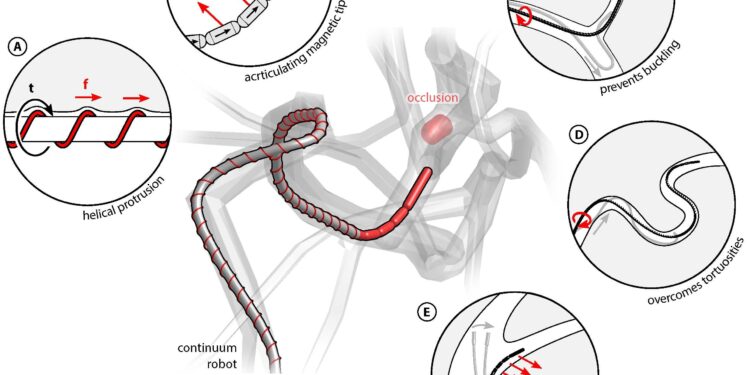Helical MCR with articulated magnetic tip. (A) The helical protrusion on the outer surface of the continuum robot, when rotating, pushes the tip of the robot forward. (B) Segmented hinged magnetic tip increases magnetic volume and decreases bending stiffness for improved maneuverability. (C) The helical robot prevents buckling and (D) overcomes tortuous vessels. (E) Articulated tip allows large tip deflections. Credit: ETH Zurich
A team of roboticists from the Multi-Scale Robotics Lab at ETH Zurich, in collaboration with several Swiss hospitals, has developed a magnetically controlled robot that could potentially be used to treat people after a stroke. Their article is published in the journal Scientific robotics.
In an ischemic stroke, a blockage (usually a blood clot or plaque) becomes lodged in tiny vessels in the brain. The result is a blockage that prevents blood from flowing to the brain, killing brain cells. Such strokes can cause brain damage and sometimes death. Their treatment is extremely time sensitive: the longer it takes to clear the blockage, the more brain damage occurs.
Current treatments involve medications that can break up the mass causing the blockage or the use of a guide wire inserted into a femoral artery and pushed until its tip reaches the blockage. Both therapies take time, meaning brain cells die while waiting for blood to reach them. In this new effort, the research team developed a new approach that allows for a much faster response.
-
Helical MCR and advanced design. (A) A magnified view of the helical mCR guidewire with a tapered nitinol core (red) for stiffness optimization. (B) A magnified view of the mCR helical microcatheter with working channel (red) for fluid injection. (C) The helical mCR has a flexible magnetic tip with hinged links and a helical protrusion on its outer surface. (D) The advancement unit operates the helical mCR by translation and rotation. (E) The motor feed roller axis is tilted to push and rotate the helical mCR. Credit: ETH Zurich
-
Helical MCR with articulated magnetic tip. (A) The helical protrusion on the outer surface of the continuum robot, when rotating, pushes the tip of the robot forward. (B) Segmented hinged magnetic tip increases magnetic volume and decreases bending stiffness for improved maneuverability. (C) The helical robot prevents buckling and (D) overcomes tortuous vessels. (E) Articulated tip allows large tip deflections. Credit: ETH Zurich
-
Measuring the working space and helix efficiency of the helical mCR. (A) A parameter scan and spike tracking reveals the accessible workspace at different magnetic field magnitudes. (B) The workspace accessible to the mCR when navigating the supraaortic arteries and operated by a three-coil eMNS. (C) The flat container model with interchangeable lumen material: PMMA, PTFE and silicone. (D) The comparison between a helical device actuated by clockwise rotation and a device without helical projection, actuated by translation and rotation. The propeller engages the soft material and, as it rotates, generates a forward thrust force. (E) Propeller efficiency: the continuous robot is inserted as much as possible into three tortuous container designs with three different materials for different levels of engagement (PMMA, PTFE and silicone). For each model, the mCR inserts in three ways, first by pressing only, then by rotating counterclockwise, and finally by rotating clockwise. Credit: ETH Zurich
The team involved developed a screw-shaped robot small enough to fit inside tiny blood vessels. Applying an external magnet causes the robot to spin, propelling itself forward. The team added a soft tip to the front of the robot to prevent damage to blood vessels.
According to the team, the robot could be used to move quickly through blood vessels until it reaches a blockage. It could also be inserted much closer to the brain. Once the blockage is reached, the robot could be used to pierce the material causing the reflux, allowing blood to pass through again.
So far, the team has tested their robot on silicon models, on a human placenta in their lab, and on a live pig. The robot performed well enough to continue testing, with the goal of treating human patients in the near future.
-
Side-by-side comparison of in vivo, in vitro, and in silico navigation. (A) In vivo navigation. It serves as ground truth for simulated navigations. (B) In vitro navigation. (C) In silico navigation. Credit: ETH Zurich
-
In vivo navigation. (A) Lateral and anteroposterior view of porcine vascular anatomy. (B) 3D representation of porcine vascular anatomy. (C) In vivo navigation in millimeter-sized vessels with injection of contrast product (angiography) and control at low magnetic fields (10 mT), with a turn of more than 90°. Credit: ETH Zurich
More information:
R. Dreyfus et al, Agile helical magnetic robot for improved endovascular access, Scientific robotics (2024). DOI: 10.1126/scirobotique.adh0298
© 2024 Science X Network
Quote: Magnetically controlled robot can move through arteries to treat stroke patients (February 15, 2024) retrieved February 15, 2024 from
This document is subject to copyright. Apart from fair use for private study or research purposes, no part may be reproduced without written permission. The content is provided for information only.



